Hardware Setup
We mentioned already the tool-less design of the case. In practice, this helps to shave a few minutes off of the time required for assembly. Realistically, it's not a huge advantage, but we do like the feature. There are a couple of areas that continue to require a screwdriver, however. First is the expansion card mounting bracket. Not only do they require a screwdriver, but we really don't like removing both screws just to add one card. The other area that still required a screwdriver was the HSF mounting. True, it does include thumbscrews, but unless you have Gumby fingers crossed with the strength of the Incredible Hulk, you won't be able to get at the two screws located near the front of the chassis, as they are blocked by the HSF. In fact, even using a screwdriver was a little difficult to get the screws back in place.First, let's start with a reminder to anyone out there who thinks that they're too good to read a manual: save yourself some time and have the Installation Guide next to you while you set up the SN25P. Due to the tool-less design as well as the air-flow shrouds around the CPU, you'll save yourself some time and confusion by referring to the manual. We had a few moments of confusion when assembling the case and the Guide was very clear and methodical in going through the entire installation process. Shuttle has clearly put some effort into making their manual both concise as well as accurate. Every one of the "gotchas" that we encountered in dismantling and assembling the case was covered, as well as several that we would have overlooked.
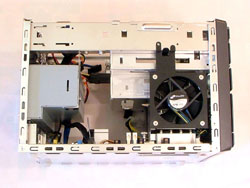 |
 |
| Click on images to enlarge. | |
As for the assembly process, we start by removing the cover as usual. Doing so is easy enough, as you simply unscrew four thumbscrews. Next, we pull out the drive cage. There are two plastic plugs holding it in place, and pulling those out and sliding the cage back will get it out of the way. From here, things get a bit trickier. Looking at the CPU socket, it's clear that you want to remove the HSF, but the exact means to do so are not immediately obvious. The manual explains that you need to remove the air guide first by "gently lifting up on it." Well, it might require a bit more effort than being "gentle", but popping out the plastic clips at the front of the case first makes it pretty easy. Finally, the CPU HSF is secured by four thumbscrews, but two of them are rather difficult to reach. We used a screwdriver to loosen the two at the front of the case, while the other two were loosened with our fingers. Then the HSF comes out and you have access to the CPU socket.
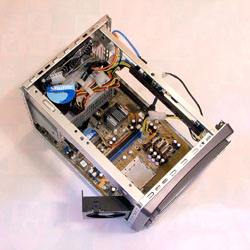 |
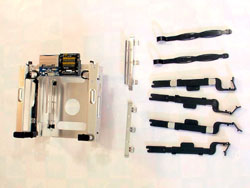 |
| Click on images to enlarge. | |
At this point, you can also swing out the fan on the left side of the case, which makes it extremely easy to insert the CPU itself. The next step is crucial, however: snap the fan back into place before mounting the HSF on the CPU. If you don't do this (we didn't initially because we were stupid and didn't read the manual), you can't get the fan back in place. The air guide for the HSF can be reinstalled after the HSF is screwed down. Installing the RAM at this point also makes sense, and you could even do that before putting the HSF back in; it really doesn't matter much.
With the drive cage removed from the case, it's time to install your drives. First, remove the plastic rails and snap them into place on the sides of your optical drive. Before sliding the drive back into place, you may need to install an IDE/SATA hard drive or a floppy drive. For the HDD, four metal prongs stick up from the bottom of the cage and you simply press the HDD into place over these points. The floppy drive uses plastic drive rails and slides into place instead. If you use a HDD in this lower location, there are four rubber "vibration dampeners" that should be placed on top of the HDD. These will hold the HDD in place once the DVD is inserted above, which is the final step in assembling the drive cage.
Shuttle mentions that the rubber pads help to reduce noise from system vibration, but as far as we can tell, they are there to prevent the drive from lifting up off the pegs. Also included are two metal "EMI shields" that snap into place just below the optical drive and at the top-front of the 3.5" bay. These didn't really "snap" very well, and came loose after we installed the DVD into the cage. We're not sure if they really help all that much in reducing EMI, and since we ended up removing the HDD from this drive bay and moving it up top, we took out the EMI shield.
With the drive cage fully prepped, it can then be placed back into the case and secured via the two plastic plugs. There are also plastic clamps that will hold the DVD in place when the plugs are pressed down. We would like to mention that some users may find the space at the rear of the optical drive to be slightly cramped, particularly if they are using a longer drive. Most modern CD/DVD drives are shorter than models manufactured several years ago, and while either will fit, the newer models leave more room for the cables and such. (We used an older, longer CD-RW drive, which is why we noticed this.)
Installing the hard drives comes last, and there are four plastic "rails" that you snap into place on the sides of the HDD. You can only use the top HDD drive locations with SATA drives, as there is no IDE cable available for this area. Conveniently, however, the SATA data and power cables are already in place once the drives are installed. The rails attach to the HDD by flexing them slightly to get the two metal prongs on the ends into the drive holes. Once the prongs are in place, a third plastic nub snaps into the center hole and keeps the rails from sliding or falling off. Then the drives can be placed into the top "front first" and a plastic clamp on the other side attaches to the chassis and holds the drive in place.
 |
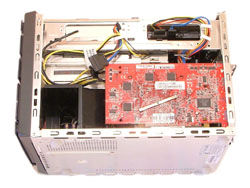 |
| Click on images to enlarge. | |
With everything installed, you can now connect the cables to all the devices and get ready to power up the system. We installed the graphics card as the final step, and we were sad to see the return of the typical metal door and two screws for securing the expansion cards. With all the effort that went into the design of the rest of the case, we wish that something could have been done to carry on the tool-less installation to the graphics card. It wasn't overly difficult, but after the hard drive and optical drive rails, it stands out.
We've gone into a lot of detail on the setup process not to make it sound difficult, but to try and help you visualize the whole installation process. Just looking at the pictures, some of the design may not be immediately clear. All told, it really is an intelligent design. Again, we just wish that the expansion slots had received some further attention, as installing the graphics card was disappointing after dealing with the rest of the case.


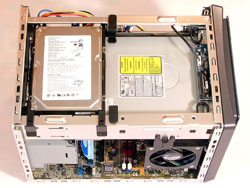








30 Comments
View All Comments
JarredWalton - Wednesday, March 9, 2005 - link
Feeling a little melodramatic, are we Grug? "5X and look terrible." Yes, and we're looking at massive 50K file sizes. The larger JPG was provided from Shuttle, so converting it to a different format would have reduced the size, but it wouldn't have improved the quality. In the future, I'll be sure to use GIF/PNG for such screenshots, but given that we're only saving 120KB of size for the whole article, it's not a big deal.As a side commentary: If you're surfing on a modem, each page of AnandTech (with ads) would still come in at about 170K without any additional images. The entire article with thumbnails comes to about 1.2 MB, and the size of all 12 pages with additional layout data would be around 3 MB. An increase of 3% or less in total content size (not even counting the higher resolution images). I don't see why anyone would notice or care.
As it stands, I don't have the original screen captures, so we're stuck with the gigantic JPG images that show compression artifacts when you zoom in to 200% or more. Sorry.
grug2k - Wednesday, March 9, 2005 - link
Ugh. Please use 8-bit PNG or GIF for your CPU-Z screenshots and the like. Those JPEGs are 5x the size and look terrible.JarredWalton - Wednesday, March 9, 2005 - link
re: #17 - Updated nForce4 informations:The nF4 Standard version does not support SATA-II and there is supposedly a mintor difference in the networking controller. Nothing major relative to the Ultra, I'd say.
JarredWalton - Wednesday, March 9, 2005 - link
Remember that the relative size of this case isn't that bad. It's about the same as the Soltek cases, and is roughly 1" longer, wider, and taller than the G5 XPC chassis. Are people really that concerned about an extra inch? I'm not.The lack of a PCI slot is something of a problem for now. If you can get a PCIe card with VIVO, you can get around that limitation, but that's about all I can say for now. Are there *any* X1 PCIe cards on the market yet? I'm not aware of any, and after almost a year of existence that's rather telling. NICs will probably be the first thing to show up, but more people are interested in audio and TV-tuner than in network support, I think.
Finally, I was incorrect in my classification of the chipset. It is actually the "nForce4 Standard", which is not a version I had heard of until now. Aparently it adds official 5X HT support and the hardware firewall. Really, I'm not entirely sure how it's different from the Ultra. The article is updated with this information.
arswihart - Wednesday, March 9, 2005 - link
it is nice, but I really appreciate an SFF when its as small as, say the Zen st62k, which I bought for my parents.When an sff gets to the size and price of this sn25p, it gets harder to choose this rather limiting and relatively expensive alternative to a standard ATX case with quiet cooling.
eastvillager - Wednesday, March 9, 2005 - link
I think the price is fine, just look at what you get, lol.Custom case, nf4 mobo, custom 350watt ps, drive cables, heatsink/pipe, 5 fans, etc.
This isn't the box you use to build your pvr, so don't worry about no pci slots for a tv tuner. If you want to build a pvr/htpc/etc., pick a smaller box.
Nice review, btw. :-)
GoatHerderEd - Wednesday, March 9, 2005 - link
#13 and everyone complaining about price: Shuttle can demand that price. They were the first, and they have some of the best quality or at least perceived quality. If people wouldn’t buy at that price, it wouldn’t be that high.I don’t see you complaining about Intel Prices, it is a very similar pricing strategy.
WooDaddy - Wednesday, March 9, 2005 - link
$400+ is the killer for me.. I think Shuttle is losing sight here..Jarod, let us know when you update those graphs. That's the real kicker for most of us here too. Subjective audio analysis doesn't really do it for me. BTW, just your personal opinion.. is it still safe to go AGP for the next 2+ years?
What I'd LOVE to see is a version of the Kloss KL-I915A with socket 939 and Nf4. Check out http://www.klosspc.com/ and you'll see what I mean..
Hell even the Asus S-presso would be nice..
arswihart - Wednesday, March 9, 2005 - link
i think it would have been better to have a pci slot than a pcie slot, thats really the worst thing about this sff imosideshow23bob - Wednesday, March 9, 2005 - link
Is anyone else concerned about the lack of PCI slots, wouldn't that be necessary to install a tv tuner, unless you went with an ALL In Wonder GPU? Do they make tuners for PCIex1?